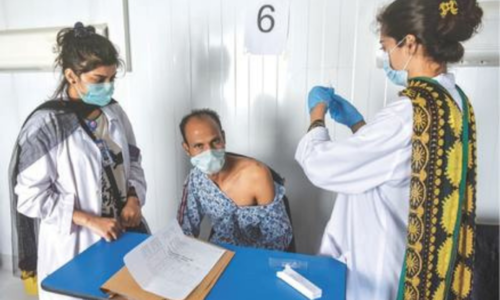AS Covid-19 cases rise across the country, it seems to be a matter of time before strict public health measures designed to stem the virus’s spread will be implemented. These steps will be accompanied by the same types of issues regarding socioeconomic vulnerability witnessed earlier between March to June.
To some extent, the government rightly prides itself over its socioeconomic response to the virus. The relatively efficient expansion of the flagship BISP cash transfer scheme to include new enrollees and the overall scale of disbursement has been impressive.
A second wave of the virus and its accompanying containment measures pose a complex set of challenges for policymakers. These challenges gain further salience in a context currently marked by rapid food inflation. Contemporary vulnerability has multiple dimensions, livelihoods are already under pressure and incomes remain squeezed. The government needs to ask itself two important questions in the coming weeks: firstly, did the first set of vulnerability-addressing responses achieve their intended goal? Secondly, will they prove to be sufficient this time around?
This piece does not propose an answer to either of these questions. However, it attempts to provide a framework through which they may be answered.
A new wave of the virus and its accompanying containment measures pose a complex set of challenges.
One aspect of the past social protection response that deserves scrutiny is the metric being used to evaluate its success. So far, the focus has been on ‘output’ metrics, rather than on outcome ones. What this means is that the government has fixated on numbers — people/businesses reached, amount disbursed — rather than an evaluation of whether these outputs actually addressed vulnerability.
Extant survey data tells us that the number of households reporting a livelihood shock of the scale that required some form of assistance — from family/friends or the government — is very high. In some estimates, it was reported as high as 50 per cent. The corresponding number of households reporting access to Covid-19-related government assistance is closer to 12pc.
An accompanying point is with regard to particular types of populations that require targeting for vulnerability-related assistance. Various researchers have mentioned that the pandemic’s urban bias (related to density and population), and the corresponding public health measures arguably make urban informal-sector workers more vulnerable than the rural poor. However, Pakistan’s social protection mechanisms — given their reliance on the poverty scorecard method that places greater weightage to asset and consumption scores — are geared towards addressing persistent vulnerability, rather than the type that’s induced by an exogenous shock.
The challenge in reaching these populations is immense, and one that requires considerable state capacity. Identifying vulnerable groups in a population characterised by frequent displacement and migration is a challenge, and one that poses an additional set of health-related complications. The case of India, where mass migration accompanied the ill-timed and communicated lockdown, is instructive in this regard.
At the same time, a higher level of difficulty in targeting should not in itself be a reason to give up. There are several tools that the government can draw on for this task. The first and most obvious one is to carry out district-representative surveys ahead of any public health measures being undertaken. The ideal time to do this would be now, when cases have not yet reached a point necessitating harsh lockdowns and restrictions on economic activity. These surveys would also be able to provide reasonable evidence of the past success of the cash transfer scheme in terms of the types of population reached.
Using survey data would also be able to establish the differential impact of vulnerability across different sectors of the urban economy — manufacturing, home-based work, construction, and retail-wholesale trade. It can then be used to identify possible points of contact within civil society that would help reach out to at-risk populations.
A second mechanism would be to rely on existing constituency-based political structures. For the past decade, there has been a general reluctance to involve political actors in the design and implementation of social protection and welfare measures, largely in a bid to keep them non-partisan and programmatic. The historical case of zakat and Baitul Maal funds serve as cautionary reminders of how unaccountable political control over welfare measures can result in patronage-based outlays that have little consideration for actual need.
However, there are some intrinsic benefits of involving political input into welfare programmes beyond the obvious ones of ownership and electoral accountability. In the current structure of Pakistani politics, the constituency already serves as the key arena in which citizens claim rights and access to services. A sizeable pool of party leaders and activists are usually tasked with running party affairs in the constituency, and elected representatives are first and foremost concerned with constituency-related affairs. Livelihoods and associated vulnerabilities are one such affair.
Politicians can engage with constituents in relevant localities to obtain specific information on how the pandemic may have impacted their livelihoods in either urban or rural areas in general. They can also receive feedback on if current policies designed to limit the impact of Covid-19 are working and what else can be done. Such exercises constitute ‘learnings from the field’ that can be compiled into ‘fact-finding and assessment’ documents that summarise the feedback and views received from grassroots supporters and constituents. Ultimately, these can feed into higher tiers of administrative decision-making — the district, divisional, or the provincial tier — thus opening up insular and mostly bureaucratic bodies to new sets of information.
The core task of the measures suggested here is to widen access to information and data that decision-makers may not have. The country’s virus status is currently at a particular point in time where such measures can have the greatest amount of impact because they’re sequenced, unlike in the first wave, prior to any welfare interventions being designed and undertaken. This should help make them even more effective and efficient.
The writer teaches politics and sociology at Lums.
Twitter: @umairjav
Published in Dawn, November 2nd, 2020













































